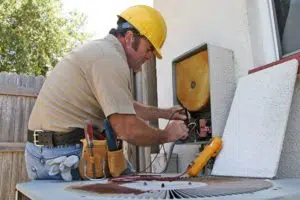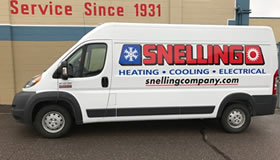Helpful Information When Buying A Gas Furnace
Snelling Company knows that replacing the old furnace in your central heating system with a new, more efficient model can offset volatile energy prices. Money aside, today’s furnaces pollute less and boost comfort by producing heat more steadily than older furnaces.
Size Matters
The furnace’s specifications should fit your needs. A furnace that is too small won’t keep your house comfortable during extremely cold weather.
Partly to avoid that possibility, the furnaces in most homes are larger than necessary. Initial cost is only one of the drawbacks of that strategy. A furnace that’s too large will cycle on and off more frequently. That puts more wear on its components, wastes energy, and might cause the temperature to vary uncomfortably. Also, a larger replacement furnace might require larger ducts. Without the right size ducts, airflow can be noisy.
To be sure of correct sizing and a proper installation, choose a reputable contractor who will take the time to calculate your heating needs according to an industry standard such as in “Manual J HVAC Residential Load Calculation” of the Air Conditioning Contractors of America. Such calculations take into account the climate and the size, design, and construction of your house. Once the furnace is installed, maintain it regularly according to the manufacturer’s recommendations. Our survey helped to confirm this advice. When we asked about the most common reasons for service calls for furnaces, contractors cited human error, inadequate maintenance, for example, or improper installation, twice as often as defective equipment. Read our frequency of repair report for which brands or the most and least reliable.
Efficiency Also Matters
 Gas is currently the most common heating fuel and most new central-heating systems use gas. How efficiently a furnace converts gas into heating energy is reflected in its annual fuel-utilization-efficiency (AFUE) rating, which is measured as a percentage. The higher the number, the more heat the furnace can wring from each therm of gas. Since efficient furnaces generate fewer emissions, environmental considerations might also influence your decision.
Gas is currently the most common heating fuel and most new central-heating systems use gas. How efficiently a furnace converts gas into heating energy is reflected in its annual fuel-utilization-efficiency (AFUE) rating, which is measured as a percentage. The higher the number, the more heat the furnace can wring from each therm of gas. Since efficient furnaces generate fewer emissions, environmental considerations might also influence your decision.
Furnaces have become more energy-efficient over the years. A gas furnace made in the early 1970s typically has an AFUE of about 65 percent. The lowest efficiency allowed by law for new gas furnaces is 78 percent, and some new models achieve 97 percent, near-total efficiency.
The price of a furnace generally rises in step with its fuel efficiency. A furnace with a 90 percent AFUE might cost $1,000 more than a similar size unit with an 80 percent AFUE. But you can often recoup that additional cost through lower fuel bills over the life of the furnace, especially in regions such as the Northeast and Midwest, where winters can be harsh. How quickly you recover the investment depends on more than just AFUE. The electricity to run furnaces with different AFUEs can vary significantly. The climate where you live, how well your home is insulated, and your local gas and electricity rates also affect payback times.
As you decide, insist that the contractor select models in a range of efficiencies and calculate the annual estimated operating cost of each model you’re considering, rather than simply estimating it. The contractor can complete those calculations by plugging information on each unit’s AFUE and electrical consumption, local utility rates, and characteristics of your home into one of several computer programs designed to easily calculate estimates. Make sure that the quotes also include the cost of any changes to venting required by any appliances in the home.
Other questions to ask the contractor: Is the model you’re considering fairly new, introduced, say, two years ago or less, and thus relatively untested? If it’s an older model, has the contractor noticed any reliability problems with it?
You can make your home more energy-efficient in several ways. Turn down the thermostat in winter; just two degrees cooler will save you money and reduce emissions by about 6 percent. You might not even feel the difference, especially at night or when you’re out of the house—a programmable thermostat can help here. Draw the curtains at night to block the chill from a cold window. Keep the windows covered on sunny days during the summer, and uncover them on sunny days during the winter to benefit from some free solar heating. Reduce heat loss from ducts by sealing leaks and, where feasible, insulating ducts.
Most and Least Reliable
If you have to replace your furnace, you’ll be glad to hear that today’s more-efficient gas furnaces can save you p to $40 for every $100 you spend on fuel compared with older models. They are also, on average, less likely to need repairs
Gas Furnace Features
 Each brand of furnace offers a similar array of key features, depending on price. The furnace features most often highlighted in product literature and sales pitches are generally the ones found on the higher-efficiency models, but some manufacturers also offer them on premium versions of low-efficiency furnaces.
Each brand of furnace offers a similar array of key features, depending on price. The furnace features most often highlighted in product literature and sales pitches are generally the ones found on the higher-efficiency models, but some manufacturers also offer them on premium versions of low-efficiency furnaces.
Variable-Speed Blowers
These can deliver air slower, while often making less noise, when less heat is needed. That produces fewer drafts and uncomfortable swings in temperature.
Variable Heat Output
Available on some furnaces that have a variable-speed blower, this feature can increase efficiency and comfort by automatically varying the amount of heat the furnace delivers, usually between two levels. The furnace can thus deliver heat more continuously than could one with a fixed heat output.
Air Filtration
Fitting a furnace with an electrostatic filter, which uses an electrical charge to help trap particles, or a high-efficiency particulate-arresting (HEPA) filter can reduce the amount of dust blown through the heating system. That might help people with asthma or other chronic lung diseases, but there’s little evidence that other people need such filtration.
Dual Heat Exchanger
Heat exchangers are the components that draw heat from the burned gas. To draw more heat from the air they burn, energy-efficient furnaces supplement the primary exchanger with a second exchanger. Because the exhaust gases in that second exchanger might yield a corrosive acidic condensate, the second exchanger is made of stainless steel, lined with plastic, or otherwise protected.
Ignition System
Fewer and fewer furnaces have a pilot light—a flame that burns continuously, awaiting the next command to ignite the burners. Furnaces with intermittent, direct spark, or hot-surface ignition do away with the constant pilot light in various ways. That increases efficiency and is usually reflected in a furnace’s higher AFUE rating.
Zoned Heating
This feature uses a number of thermostats, a sophisticated central controller, and a series of dampers that control airflow to deliver different amounts of heating or cooling to different parts of the home. The larger the home, as a rule, the more useful zoning is. That’s especially true if sections of the home have different heating or cooling requirements, because of wide variations in the number or type of windows, for example. But contractors we interviewed said that furnaces connected to zoned ductwork generally require more repair.

20% OFF
Save 20% off labor charges on a new installation of an Air Conditioner or Furnace
Not valid with any other offer. Coupons must be presented at the time of service. Offer valid for new customers only.
Request Appointment

"*" indicates required fields




